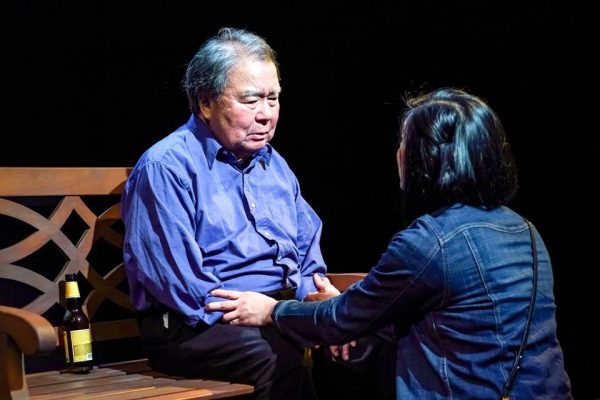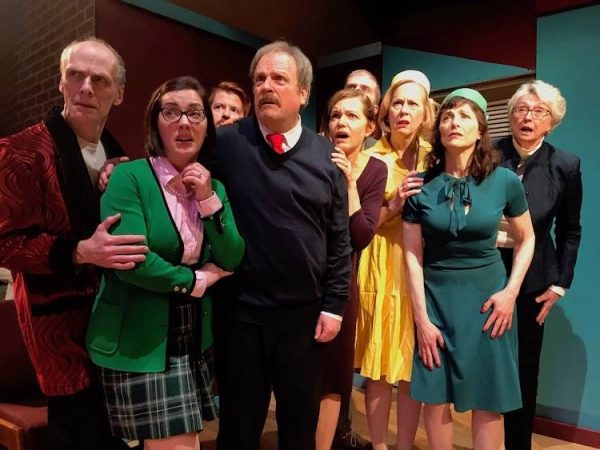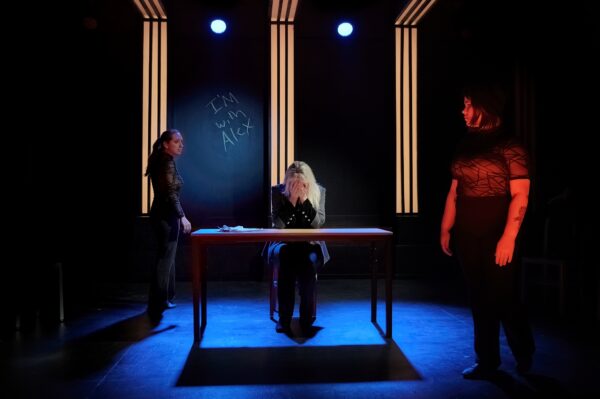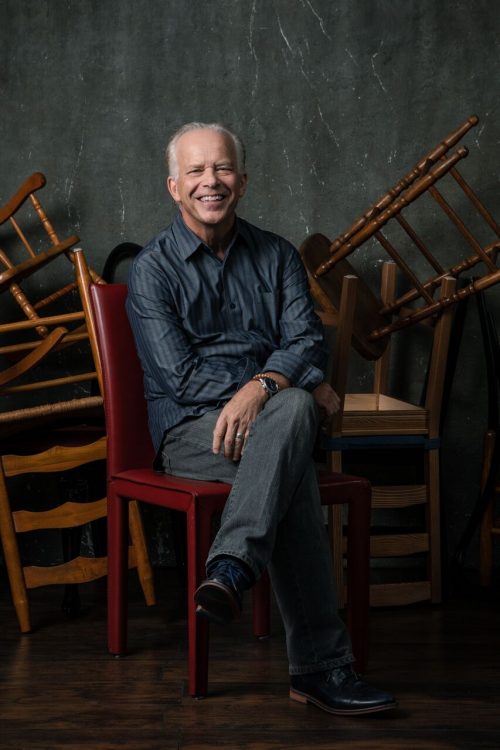I saw a lot of theater last weekend, most of it coming from smaller theater companies, and most of it was compelling and well done as different stories were told about a rather vast array of characters in a variety of unique situations.
2018 is off to a strong start for Seattle Theater!
Mostly.
(Does that mean we’re due for a spell of ‘meh’ theater? Law of averages would suggest so…)

AMERICAN HWANGAP tells the bittersweet story of Min Suk Chun (Stephen Sumida) on the occasion of his 60th birthday (hwangap), a milestone signifying the completion of the Eastern Zodiac, as he returns, following a 15-year exile, to his ex-wife and now adult children.
Tickets available at our box office or in advance here: http://bit.ly/AmericanHwangap. Photo credit: Alabastro Photography
Review: American Hwangap by Lloyd Suh. Produced by West of Lenin/A.J. Epstein and SIS Productions. Directed by A.J. Epstein. Scenic Design by Lex Marcos. Costume Design by Sarah Mosher. Lighting Design by Zanna King. Sound Design by Brendan Patrick Hogan. With Michael Cercado, Kathy Hsieh, Mara E. Palma, Stephen Sumida, Moses Kristjanson Yim. Now through February 25, 2018 at West of Lenin/Fremont.
We’ll start with AMERICAN HWANGAP, a family dramedy from playwright Lloyd Suh and produced locally by West of Lenin’s A.J. Epstein and SIS Productions. It’s about a Korean-American family torn apart by the departure of the father Min Suk Chan who fled back to Korea after he lost his engineering job a number of years ago leaving his wife and three kids behind in Texas. Min Suk is turning 60 so it’s time for his “Hwangap” a big birthday celebration and we’re totally going to cheat and let Wikipedia explain what it is:
Hwangap (Hangul: 환갑; Hanja: 還甲) in Korean, Kanreki (還暦/かんれき) in Japanese or Jiazi (甲子) in Chinese, is a traditional way of celebrating one’s 60th birthday in East Asia. The number 60 means accomplishing one big 60-year cycle and starting another one in one’s life following the traditional 60-year calendar cycle of the lunar calendar…In the past, a person’s average life expectancy was much lower than 60, so Jiazi or Hwangap or Kanreki also meant a celebration of longevity. The celebration party is also a wish for an even longer and more prosperous life. This party is customarily thrown by the children of the person who is turning 60, unless that person does not have any children, in which case there’s no party at all. On one’s Hwangap family and relatives prepare a big birthday celebration with lots of food.
It’s a charming concept but it’s also one fraught with pitfalls for anyone estranged from their family. In American Hwangap, Min Suk’s former wife Mary and his youngest son Ralph are excited to bring him back to Texas to celebrate the occasion. Meanwhile, daughter Esther and elder son David are less enthused; they haven’t forgiven their father for leaving the family. The 90 minute play explores Min Suk successfully reconnecting with former wife and youngest son and trying to do so with the two older children in an interwoven series of dialogues between the various family members with all discussions with David happening via telephone; he now lives in New York and resists returning to Texas to see his father.
The charm of these characters, as created by Mr. Suh, are the chief attraction for this play. Each one has a unique personality and the playwright has done a fine job of defining their characters and creating tangible connections between each family member while avoiding cliches. The dad isn’t a monster but a very flawed guy with a lot of charm; he’s made terrible mistakes but he’s not a terrible person. Not all of his children can forgive him for his flaws and that was another plus for me about this play….not everything is tied up with an easy solution. There are still questions to be answered and relationships that need further mending. Like life, this play isn’t about tidy pat endings. I admire it for being organic to the truth of its characters.
That said, there are some issues with some of the character development. I think the mom, Mary could have been developed more fully; she seems to forgive Min Suk a bit too easily. And, the youngest son is a “man child” living in Mary’s basement who is….autistic? Lazy? Odd? A combo platter of all three? Ralph has withdrawn from participating in society as an adult and is childish to the point of seeming a bit more than just “being on the spectrum”. Here is a case where the character might be OVER written and too much like a “quirky character” in a play and not a fully formed believable member of this family. I think the actor, Michael Cercado does a fine job of breathing life into Ralph but I wish the character wasn’t so broadly written.
All the performances are quite good here with Stephen Sumida, charmingly roguish as the dad and Kathy Hsieh, a tad young to pull off a character that’s pushing 60, channeling quirky TV mom realness as Mary. Moses Krisjanson Yim was appropriately fraternal as the long distance brother who loves his siblings and Mom but still distrusts Pop. And, Mara E. Palma does a lovely job as the perpetual middle child who hasn’t quite found her place in life. The relationships between the three actors playing the siblings is especially well done.
The production is well staged by Mr. Epstein within the simple basic design scheme of the production. It’s a solid piece of theater that mostly works due to the charm of the characters and the actors playing them and the dynamic created by Mr. Suh’s interesting look at a Korean American family.
Review: YOU ARE RIGHT, IF YOU THINK by Luigi Pirandello. Adapted and Directed by Charles Waxberg. Produced by Theatre 9/12. Music and Sound Design by Mario Gomez. Lighting Design by Quinn Lincoln, Costume Design by Kyleigh Archer. With Michael Oaks, Lisa Carswell, Zandi Carlson, Benjamin Nickols, Meredith Binder, Michael Ramquist, Mary Murfin-Bayley, Eric Smiley, Susan Echols-Orton, Buddy Todd, Margaret Bicknell, Laura Bannister. Now through February 25, 2018 at Trinity Episcopal Church/Seattle.
There’s a different kind of drama that’s also kind of a comedy, (at least in this production) of Luigi Pirandello’s 1917 Così è (se vi pare) the Nobel Prize winning Italian playwright’s absurdist-ish tragic farce…or, is it a farcical tragedy? Sometimes titled in English as “Right You Are (If You Think So)” here director and adapter Charles Waxberg has titled his version, YOU ARE RIGHT, IF YOU THINK which follows the same plot as the original as it exams a small town dealing with two sides of a story…which side is “right” and which side is not, is the driving force of the piece but one which ultimately isn’t really answerable. And, as Pirandello seems to argue, does it matter? Does an issue or a question have to be answered? Are there only 2 choices to choose from? Maybe answers lay….else where or in between those choices?
The play opens on our rather languid and louche “master of ceremonies”, here named Leon who impishly acts as an instigator and commentator on the actions of the characters and the plays themes. Leon is apparently a bit of a freeloader and rogue, living with his sister Grace and her husband, Frank, the local district attorney and their adult daughter Clara in a small provincial city circa…1960 or so, judging by the costume design and the fact Leon is wearing sexy lounging pajamas and smokes reefers.
The citizens of the town are gossiping about the odd household of Mr. Ponzi which seemingly consists of himself, a not really seen wife and his mother-in-law Mrs. Skellton. It turn outs that Ponzi is claiming his first wife, (Mrs. Skellton’s daughter) is dead and Mrs. Skellton doesn’t accept that his second wife is not her daughter, while she claims the opposite, that Ponzi is crazy and…something like that. It’s all rather confusing which is sort of the point of the play as the plot consists of the town snooping around trying to get to the bottom of the mystery on who is the crazy one and who is the mysterious woman living in the Ponzi household. Is the first Mrs. Ponzi dead or a ghost or is it a second Mrs. Ponzi or….
Pirandello can be very heavy handed in the wrong hands…it’s a style of play writing that is long out of style and what seemed daring and arty in 1917 can feel plodding and cumbersome today if played incorrectly. Fortunately Charles Waxberg has gone with a lighter playing style with more emphasis on the silly absurdism and less on the heavy drama and philosophical questions the play raises, which to be honest, are still relevant questions to ask in the Age Of Trumpism. We live in a media saturated world of truths, half truths, lies and “fake” news that is sometimes real news and sometimes not and sometimes we’re not so sure. Pirandello’s themes are VERY topical in 2018.
Mr. Waxberg has kept the tone light with his adaptation as well with the direction of the actors and the design elements. We have wry comic performances from most of the actors and they’re all wearing rather wonderful mid-century costumes from designer Kyleigh Archer who does a terrific job of outfitting this large cast in colorful clothes circa 1960 or so. The pace is brisk and while the plot is at times a bit confusing (which is the point of the play) it moves along aided by the performances from the cast.
Michael Oaks is the chief charmer here as the wickedly fey Uncle Leon who pokes and prods and teases the other characters into gossipy action. It’s a winning performance that nicely holds together the ensemble. There’s also amusing work from Lisa Carswell as Leon’s sister and Michael Ramquist as the officiously charming brother-in-law.
All in all, it’s an interesting and mostly amusing take on Trumpian Themes and a rare chance to see a production of a Pirandello play. For hardcore theater fans interested in a wide variety of theater from all eras, it’s very much worth checking out, if only for the topicality of the subject matter.


















